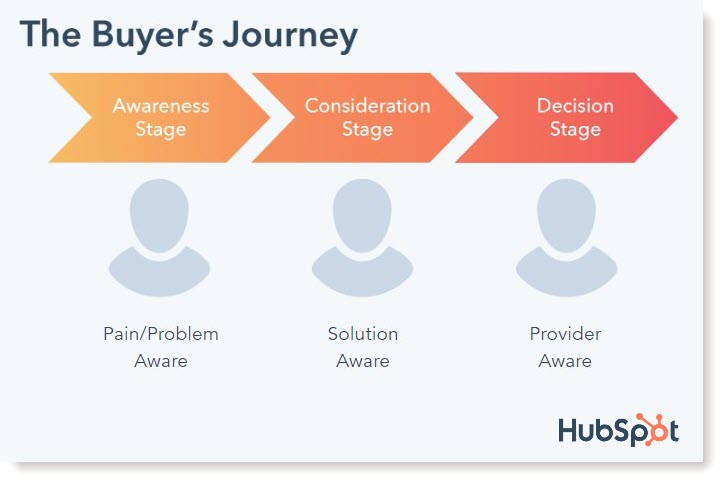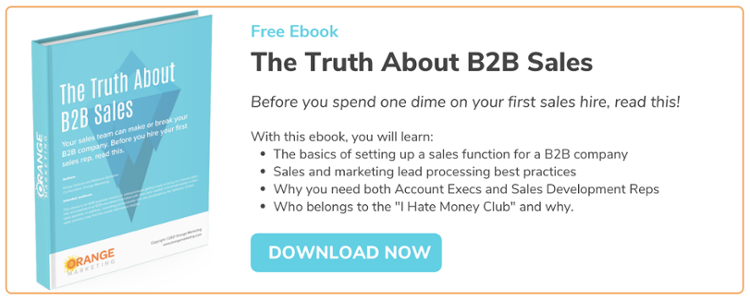
Your investors want to see a scalable, repeatable, and predictable sales process to help them determine when (or if) they will get their money back. Many B2B startups approach their sales by hiring a seasoned rep who will pound the phones and get deals. Unfortunately, that will never provide a scalable, repeatable, and predictable process.
An attractive sales strategy includes identifying customer profiles and buyer personas, a documented and proven sales process, filling critical sales positions, and hiring professionals who will follow your processes. Here is how to set up a sales team your investors will love!
Start Telling the Story
Customer Profiles & Buyer Personas
Outlining your customer profiles and the different buyer stages each of them go through helps your sales team know what crafted marketing messages to send prospects and keeps your sales and marketing teams on the same page.
Customer profiles are the general demographics (male, female, income bracket, etc.) and job roles that make up your ideal customer. You may have a few. It is best to focus on one, maybe two, profiles that are likely to make you the most revenue.
Next, you will need to describe the three stages that customers will follow along their "buyer journey" (aka buyer cycle): Awareness, Consideration, and Decision.
A prospect in the Awareness stage is just starting to learn about a problem or opportunity. Someone in the Consideration stage is becoming aware of solutions or ways to solve a problem or take advantage of an opportunity. Finally, when a prospect is in the Decision stage, they are ready to kick around what vendor or business they want to use.
Your sales team should work with marketing to craft messages unique to each customer profile and buying stage. Automating personalized emails makes your sales team more efficient. Personalization also ensures sales is not confusing your prospects with messages that make no sense to where a prospect is in the buyer journey.
The Truth About B2B Sales - Get the Ebook!
You Need a Sales Playbook—Spell it all Out!
It is best if you had a guide for your sales reps to follow with clear objectives regarding sales processes. Your playbook should include:
- What constitutes a sales lead, and what actions will move a lead down the sales funnel
- Timing and frequency of communication to prospects
- A documented lead handoff process from marketing to sales, and back again if necessary
- What collateral (one-pagers, videos, case studies, etc.) sales should use at the various buyer stages
- What action should follow when leads go cold—flip lead back to the marketing team to nurture or drop the lead altogether?
- What automated workflows to use
- How to personalize messages for best results
- What CRM processes and note-taking must occur
Not only will this playbook guide your sales team, but it also keeps your sales and marketing teams on the same page and makes it easier for you to train new salespeople as you grow.
Setting Up a Good B2B Sales Process
Sales Enablement
There is a lot of technology on the market to support your sales team in connecting with leads and closing more deals. We recommend B2Bs use HubSpot for various reasons. Still, in terms of sales, it is a terrific platform to stay in regular communication with leads, manage sales tasks, and access reports with deep insights into your sales pipeline.
Sales & Marketing Working Together
Salespeople are your boots on the ground and should be feeding your marketing team real-life examples of the problems your service or product solves. Sales can also leverage customer relationships and introduce happy customers willing to share their experiences to marketing.
REAL-LIFE EXAMPLE
It was near impossible for our marketing team to connect to a particular client's happy customers who were willing to share experiences for case studies—even anonymous case studies. When the sales team became involved, customers gladly got on the phone. The results of sales and marketing collaborating were night and day and many case studies were produced.
Often the relationship between sales and marketing can be strained, with many misunderstandings between the two. When both teams collaborate on content and support marketing campaigns, your company is in the best situation to optimize lead generation spend and win more business. There is a yin and yang effort between the two.
The Two Sales Roles You Must Have
For long-term effectiveness, you should have an Account Executive (AE) and a Sales Development Rep (SDR). These two roles are critical because the motivations of your AE and SDR are entirely different, and therefore what they focus on and the benefits to the company's bottom line are different.
AEs are commissioned-based "hunt and kill" focused. They work primarily on quickly winning outbound leads and tend to skip over more challenging sales.
Your SDR is typically a salaried position with tasks supporting lining up leads for AEs. SDRs focus more on inbound leads that entail a longer turnaround time and require more nurturing than your AE will provide.
When you employ an AE and SDR, you have a well-rounded way to work inbound and outbound leads. This, coupled with a well-thought-out playbook that doubles as excellent training material for the often-nomadic AEs that tend to come and go, proves to investors that you have a repeatable process and can continue to hit numbers even if an AE leaves. 
Following up on Leads
"Every single lead must be processed using a consistent process every single time.”
- The Truth About B2B Sales, Orange Marketing
Your sales team must follow up on leads. ALL LEADS. Why? Because they cost you money—a ton of money depending on the campaign. Also, you can learn from bad leads if sales provides feedback to marketing. Such communication can also resolve misunderstandings, like when salespeople fail to follow up on "bad leads" that are actually good.
For example, some AEs avoid generic Gmail/Yahoo emails and only communicate with work emails, however, many people use private emails to download free content (aka your prospect bait) or with their social media where marketing drives many expensive campaigns.
You need sales to religiously follow up on leads, including following up in the established way and cadence laid out in your playbook. Follow-ups are not a "hit it and quit it" endeavor. Nor should sales follow up on leads forever and ever because one time, they scored on a follow-up on the 100th try.
Sales should follow up as many times as you have set out in the playbook and using a prescribed process that includes personalized emails and automated workflows and sequences.
More B2B Sales Tips
For B2B founders ready to bring on a formal sales role and for executives frustrated with deal creation and predictability in their sales pipeline, we've got just the ebook. Jam-packed with real-life B2B stories of what to do and what not to do, our ebook The Truth About B2B Sales will give you:
- The basics of setting up sales processes
- Sales and marketing lead processing best practices
- Why you should be wary of lead scoring
- Revenue-reducing behaviors you need to watch out for
- and much more!
We specialize in generating leads that convert for seed and early-stage B2B SaaS startups. Download our ebook and learn from what we've witnessed time and time again.

